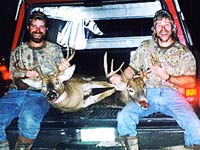HV/Series/Episode/ Work by: Mark Allen · Alex Chadwick · Carolyn Jensen Chadwick · Hillary Frank · Barrett Golding · Erica Heilman · Long Haul Productions · Larry Massett

![]() Hearing Voices from NPR®
Hearing Voices from NPR®
072 Predator: Hunter and Hunted
Host: Larry Massett of Hearing Voices
Airs week of: 2011-09-14 (Originally: 2009-10-14)
“Predator” (52:00 mp3):
For the opening of hunting season:
A teenage babysitter convinces his younger siblings he’s a werewolf… who’s going to kill them, produced by Hillary Frank (author of I Can’t Tell You) for This American Life.
Beatrice is a white toy poodle, a neighbor, and “the most evil entity, force, energy known to man. Death to humans is a mere plop of a pebble in the ocean that is the evil that you are Beatrice. Evil Beatrice the white poodle.”
Grizzly Bear 0:00-0:17
Harbor Seal 0:17-0:33
Dall’s Sheep 0:33-0:44
Timber Wolf 0:44-0:51
Moose 0:51-1:22
Cougar/Mountain Lion 1:22-1:26
Sea Lion 1:26-1:51
Porcupine 1:51-1:58
Bison 1:58-3:26
Ringtail/Rodent 3:26-3:41
Musk Ox 3:41-4:11
Columbia Black Tail Deer 4:11-4:37
Caribou 4:37-5:06
Coyote 5:06-5:25
Mountain Goat 5:25-5:48
Peccary 5:48-6:26
Mule Deer 6:26-6:58
From Sonic Scenery, an exhibit I worked on at the natural history museum in Los Angeles a couple years ago. Composers were invited to record music specifically to be heard in wings of the museum. The visitor wears a headset, which plays the compositions when triggered by remote signals in the galleries. Experimental duo Matmos took it all the way by making audio environments for each of the seventeen dioramas in the North American Mammals hall. The timechart (above) was intended to cue the visitor to move from one window to the next, but you can read along for a similar effect.
Artist statement:
In general, our work starts by taking an object, making sounds with that object, and working outward from those sounds in a free-associative manner, without a preconceived result or specifically targeted genre in mind.
In this case, we have had to reverse this process and have tried to think about the precise specifics of the North American Mammals hall and work to gather sounds that will evoke both the natural locale and the specific behaviors of the animals in the room. We decided to anchor our piece around the sounds of animals eating, breathing, and sniffing their environment, and to locate these noises of animal life against a backdrop of plateaulike drones generated with musical instruments associated with “Americana”: pedal steel, acoustic guitar, banjo, harmonica, and autoharp. Feeding peanut butter to a friend’s dog, we built up a basic library of mammalian lip-smacking, huffing, barking, whining, sniffling, and breathing noises, and combined this with a percussive battery of antler noises made by smacking deer antlers against each other and some softer rustling textures harvested by stroking and rubbing the pelt of a wolf.
The work is divided into miniature ‘cells,’ which stand in for the seventeen distinct dioramas/environments and animal species represented in the room, and this is split down the middle by a central section that corresponds to the large bison display at the far end of the room. Our work is intended to be a sound map of a walk through this room and is paced to coincide with a five-to-seven-minute counterclockwise walk through its contents
–Matmos
via futurechimp
“17 Species of North American Mammals” (2:22 excerpt) Matmos
LA’s The Natural History Museum commissioned original music compositions to accompany their 2006 exhibit Sonic Scenery: Music for Collections. Matmos’ music used the vocal sounds of North American mammals.
One of America’s oldest roadside attractions is the Linesville Spillway in northwest Pennsylvania. Tourists toss bread; carp amass at the spillway’s edges: The fish are so thick that mallard ducks hop, skip and jump on the fish’s backs to compete for a slice of bread. Original music by Tim Fite, part of LHP’s song/story series.
More music from the LHP story.
Writer (Amazon), hunter, angler, outdoorsman, Norman Strung demonstrates the shrill sound and thrill found in calling for elk. (Miss ya, Norm: “Labradors [are] lousy watchdogs. They usually bark when there is a stranger about, but it is an expression of unmitigated joy at the chance to meet somebody new, not a warning.” –Norman Strung)
Father Rupe LaRock and son Joe provide a hunter’s perspective of the annual deer breeding cycle. “You can just smell the heat and smell the rut right in the air.” Another of the Deer Stories , produced with Gregory Sharrow at the Vermont Folk Life Center.
Guns, guitars, guts, and wild game. Hunting wildlife and the wild life in the mountains of Payette National Forest. From the Chadwick’s Conservation Sound series. Audio by Micheal Scweppe.